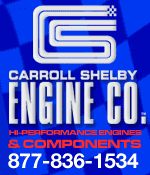 
 Main Menu
Main Menu
|
 Nevada Classics
Nevada Classics
|
 Advertise at CC
Advertise at CC
|
 June 2024
June 2024
|
| S |
M |
T |
W |
T |
F |
S |
| |
|
|
|
|
|
1 |
| 2 |
3 |
4 |
5 |
6 |
7 |
8 |
| 9 |
10 |
11 |
12 |
13 |
14 |
15 |
| 16 |
17 |
18 |
19 |
20 |
21 |
22 |
| 23 |
24 |
25 |
26 |
27 |
28 |
29 |
| 30 |
|
|
|
|
|
|
|
 CC Advertisers
CC Advertisers
|
|

10-30-2006, 09:38 AM
|
 |
CC Member

|
|
|
Join Date: Nov 2000
Location: Tucson,
Az
Cobra Make, Engine: Superformance 427 Side-Oiler
Posts: 2,156
|
|

 Not Ranked
Not Ranked
 Huh?
Huh?
But if carbs are jetted bigger for a PCV system Then maybe I should wait to see when I actually have a PCV system to see if the #66 jets I'm running now work out,I've checked the manifold vacume paths to the power valves and they were open. I changed powervalves going bach up from the 3.5 to 6.5 which I was told my carbs would handle. 
Who told you jetting and PVC systems are related?
__________________
The rest of the world can have their opinion about the United States just as soon as WE give it to them.
|
-
Advertising


10-30-2006, 08:58 PM
|
|
CC Member

|
|
|
Join Date: Mar 1999
Location: TACOMA,
WA
Cobra Make, Engine: Everett Morrision FE 427 so 2-4s
Posts: 2,008
|
|

 Not Ranked
Not Ranked
It would stand to reason if you have a vacume leak controled or not then you would need to add some gasoline somewhere else to correctfor the imbalance. One of the quick checks to see if it's rich is to let some air in by uncapping a nipple below the carb and the engine speeds up when the mixture is corrected.
__________________
Mike H
|

11-15-2006, 07:11 AM
|
|
CC Member

|
|
|
Join Date: Mar 1999
Location: TACOMA,
WA
Cobra Make, Engine: Everett Morrision FE 427 so 2-4s
Posts: 2,008
|
|

 Not Ranked
Not Ranked

Well I installed the hole and fitting in the plenum of the intake manifold. Now some more discussion.
The engine sits almost level front to back. So, the right rear valvecover filler hole shoildn't be any more oil challenged than the left front. I have breathers with top grommeted holes for both valvecovers They can either have PCV valves or elbows. I currently have a PSE breather stack with the strainer basket in the center rear of the intake manifold. I have found a plain cover plate and a cover with strainer and PCV valve for that position. The right front manifold oil filler tube currently has the usual breather cap. I have a closed cap with a hose nipple for that position that resembles the breather cap I have planed for the right rear valvecover position. Problem is the cap is a little larger than the open breather cap I have been using. The filler tube is short and lower than the valvecover and difficult to actually pore oil into.
Any way, if oil drainback is an issue wouldn't oil draining down from the rockers be helped if the PCV was removed at the rear of the intake and vented inward at the valvecovers? what I,m considering is tying the valvecovers together with the filtered fresh air source being inside my aircleaner as they are now but without the PCV valves that are now in the grommets that are in the valvecovers. Air in the valvecovers and PCV being taken out the center rear of the intake manifold.
Is the rear manifold PCV better than the fresh air in one valvecover and PCV out the other valvecover? Do I need to limit the fresh air intake and pull a partial vacume?
__________________
Mike H
Last edited by Michael C Henry; 11-15-2006 at 08:14 PM..
|

11-16-2006, 06:26 PM
|
 |
CC Member

|
|
|
Join Date: Jul 2004
Location: Alpharetta,
GA
Cobra Make, Engine: ERA #414 427 s/o w. Shelby Aluminum heads, Edelbrock Performer RPM Intake, Mighty Demon 750, Tremec TKO 600
Posts: 714
|
|

 Not Ranked
Not Ranked

Mike,
I think most people have told me that trying to pull a little vacum is a good thing and if you have too much intake, you arent' going to get that. Seems on the right side you need to have intake from either the filler tube or the valve cover, but not both. And the air is going to pull from path of least resistance. So if you have PCV in the rear, and breather on rear of right valve cover, you probably aren't going to get much pull from the left front valve cover breather. So seems if you put the PCV in the left front, then you'll get some pull from the right rear cover and rear center intake, or just cap off the intake vent and have the PCV in the right rear valve cover, with the left front being the intake and then you're getting flow from one corner to the other. Also, don't remember if you have solid lifter cam or hydraulic, but if it's hydraulic and you don't have a lifter valley pan, you'll be throwing a lot of oil up into that rear intake location which is going to cause oil to go somewhere depending on if it's a PCV or a breather there. At least it's an easy thing to play with vs having to tear something down to do it!
Scott

|

11-17-2006, 11:16 AM
|
|
CC Member

|
|
|
Join Date: Mar 1999
Location: TACOMA,
WA
Cobra Make, Engine: Everett Morrision FE 427 so 2-4s
Posts: 2,008
|
|

 Not Ranked
Not Ranked

I have the valley tray and it is a solid (shell) lifter cam. I have four access points to work with.
Pretty sure that PCV entry into intake manifold is going to be the new fitting I installed in the right side of the plenium between the carbs. The front manifold oilfiller tube ,two valvecovers each with a screw in oil filler - breather hole, and the rear center of the intake manifold base. After the trying to pour Mobile 1 in (the oil bottle neck is as or larger than the tube and the tube top is much lower than the valvecover). So the front intake manifold filler tube is getting lenghtened to make it as tall as the valvecover. I'm planing on making a new tube from 1 3/8" stainless tubing a few inches taller keeping the internal baffel at same height so a funnel will fitin the tube for actually pouring oil in the engine and not all over the outside of the valvecover and intake manifold. I plan on making a slight bend or kink to move the breather cap maybe a 1/4" away from the right valvecover. My old tube has some ulgly scratches in it anyway.
I'm Not liking the fresh air coming from inside the aircleaner bases as they are now. As it sets now with a PCV valve in each valvecover, when going full tilt ,they can pull enough flow into top of carbs to make a mess. So to convert those locations to breathers I would probably continue to have a mess. At this time I'm thinking about plugging the holes in the aircleaner bases and getting the fresh crankcase air from a breather (puke) tank with an air filter located on the fender wall or the like . I have an 1/2" alluminum T that I was going use to tie the breather hoses for the two valvecovers from one source out of view in the area under the carbs. I've bought a lot of peices bt knot having the complete plan there is still more to aquire. I'm still listening.
__________________
Mike H
|

11-24-2006, 12:05 AM
|
 |
CC Member

|
|
|
Join Date: Nov 2006
Location: Reedsport, OR,
OR
Cobra Make, Engine: Old ('93)CMC kit, SB ford
Posts: 68
|
|

 Not Ranked
Not Ranked
 Positive Crankcase Ventelation
Positive Crankcase Ventelation
PCV valves are very different. Not just in size but in the amount of vacume it takes to open them up. The theory of the PCV valve is to create a vacume in the crankcase, valvecovers, lifter vally, so oil will not try to force it's way out of the gaskets and past seals and rings. the vacume is created from intake manifold vacume being used through the PCV valve. When the throttle is opened manifold vacume drops and the PCV valve closes to keep the vacume in the crankcase, to keep the oil in.
Readers Digest Condensed version.......
PCV won't work if:
Too much cam...not enough manifold vacume
Too much blow by past the rings
PCV valves are rated by vacume so you may need a different pressure PCV valve.
Some are spring loaded and some work on gravity..make sure they are in the position intended.
They won't suck at WOT (wide open throttle) Not supposed to.
The hookup to the manifold should be into the main plenum of the manifold because there is a most constant vacume there. Not a manifold runner. (too many pulsations) That's good for Vacume brake booster.
The vent should be in the opposite side valve cover to vent the WHOLE engine.and the higher the filter the better. That's why most are vented from the aircleaner. Clean air goes in that tube and out the PCV and is burned up in the combustion chamber with the air-fuel mix.
Now that I have truly mixxed  you up, you should know everything there is to know about PCV valves.
Fred

|

11-24-2006, 01:39 AM
|
|
CC Member

|
|
|
Join Date: Jan 2004
Location: Rock Island,
IL
Cobra Make, Engine: SCJ429 & FE406
Posts: 63
|
|

 Not Ranked
Not Ranked
 PCV blues
PCV blues
Hi!
I have been reading the posts above and I see some really nice looking systems that you are using for crankcase evacuation.
The positive crankase ventilation system was mandated by federal law in september 1966. Its sole purpose is to capture the very toxic mixture of residual air-fuel mixture that gets blown by the piston rings and into the crankcase, plus airborne lube particles that form insde the crankcase. It is a very violent place to be on any given day!
The PCV valve must be located, either in the center of the intake manifold or on either valve cover. It must be completely airtight, mounted in a gromet or pressed into a sealed container like in the pictures of the Summit setup above. This is where air gets sucked out, but only as far as compression pulses will open the check ball inside the valve casing, assisted by the engine vacuum signal.
If you suck out air, you need to have a place for it to get sucked in too. That place is the breather on the other side of the engine, or as on older FEs, through the filler / breather cap on the filler tube on the intake manifold. This, however is not an ideal setup. If you want maximum cleanup effect, you really need to have the exit and entrance on the valve covers. This is due to the fact that oil mist, gasoline fumes and water vapors tend to rise to the roof of the building, i.e. the valve covers. Since the FE with its Cobra LeMans or Baldie valve covers is one very tall building, this is where your culprit is going to reside and cause a mess, causing oil stains and what not all over.
So, in my view and from what I have read, the valve covers need to be the north and south borders in this war.
The PCV valves are made in a myriad of configurations. What varies is mostly diamter and weight of the check ball. This is regulated by the vacuum signal that each particular engine is known to have. That means STOCK engines that idle smoothly AND have a regualr vacuum signal at 650-700RPMS.
As you get into more aggressive cam profiles, the vacuum signal starts to change and deteriorate in more ways than we can count. As we get into degree territories above 235-240° @.o50 on the FE, you need to look at other options. Notably vacuum pumps (with aggressive cams and low pressure piston rings) and / or oil accumulators and scavenging systems that operate on header collector negative pressur. But on those applications you are always having to endure very discomforting and potentially deadly vapors inside your cars as you sit at the local stoplight.
The PCV system is the single most effective, least expensive and most reliable method of pollution control ever installed on an internal combustion engine.
bye
__________________
Lima 385
|

11-24-2006, 09:56 AM
|
|
CC Member

|
|
|
Join Date: Jun 2003
Cobra Make, Engine: ERA 427 w/496 Side Oiler, roller, dual quads
Posts: 417
|
|

 Not Ranked
Not Ranked
The rush of the fuel/air mix by the PCV hole in the intake, carb base plate, where ever, creates a vacuum on the PCV valve, so that the PCV system also works under acceleration, and there is enough vacuum under most other conditions, such as cruise, that it's actually working most of the time. At some point in spirited acceleration the PCV system may not be able to handle all the blowby. This is why you see puke tanks, scavenging systems that operate on header collector negative pressure, etc.
My 2 cents...
Dan
__________________
Do you know why they call it "PMS"? Because "Mad Cow Disease" was taken. --Unknown, presumed deceased
|

11-25-2006, 01:51 AM
|
 |
CC Member

|
|
|
Join Date: Mar 2006
Location: Tacoma,
WA
Cobra Make, Engine: West Coast-450 HP 460
Posts: 347
|
|

 Not Ranked
Not Ranked

Generally alot of what has been said here is correct, but lets get down to basics.
A functional PCV system is just as important in keeping the engine clean as it is in keeping the air we breath clean. (although most greeners would have a heart attack if they saw the HC and CO numbers our exhaust blows, but thats a whole other story) All you need is a single PCV valve that is correct for the engine type and size you are running. Wherever you place it (base of carb, inline, at the valve cover) it should ALWAYS draw from the passenger side valve cover. The reason for this is that most all engines (at least the ones we are dealing with) rotate clockwise (viewed from the front) and this rotation of the crank generally causes the air in the crankcase to move over and up to the passenger side valve cover. We want to take advantage of this natural flow in removing the blow-by gases. There should be a good full coverage baffle at the connection point to prevent oil splash and oil vapor being drawn into the valve. On the drivers side valve cover, there should be a good breather cap with a hose running to the air cleaner. There should be a good baffle under this cap as well. Make sure the hose connects at a point down stream of the filter as we want to draw filtered air into the crankcase. This cap doubles as the oil fill in most applications. Any ports, fittings, breathers, oil fills etc in the intake manifold should be plugged or capped so they don't leak. Those purists with 427's can leave the oil fill/breather in the manifold in place if they want, just make sure in dosen't leak air. If your system is set up properly and your getting oil all over the place, it's because something is leaking. Fix the leaks! There is a lot of oil flying around under the covers and if you don't have good seals, it's going to get out.
The PCV system never draws a vacuum on the crankcase. It's purpose is simply to draw the volatile compounds that vaporize from the oil, moisture and blow-by gases out of the engine to prevent sludge and air pollution. When the engine is under heavy load, there usually will be positive pressure in the crankcase due to excessive blow-by. This is not a problem because during this condition the excess blow-by is simply pushed up the hose attached to the breather cap and drawn into the carburetor. If the engine is badly worn, there will be blow-by pushed up this hose most of the time which can end up oiling down the inside of the air cleaner. I doubt anyone with a Cobra would let their engine get that bad.
If you are running fuel injection, I do recommend and oil seperator or filter for the PCV hose. The reason is that these manifolds run "dry" and on engine shut-down residual crankcase fumes tend to run up the PCV hose and collect and "coke" in the manifold which gunks things up and can foul the throttle valve and idle bleed valve.
So that's it. As always, the KISS method works best.
Ray

|

11-25-2006, 11:53 AM
|
|
CC Member

|
|
|
Join Date: Dec 2000
Location: Austin, TX, US,
TX
Cobra Make, Engine: Exact427
Posts: 70
|
|

 Not Ranked
Not Ranked
 Positive Crankcase Ventilation - Another Option
Positive Crankcase Ventilation - Another Option
A different PCV approach was utilized on some engines during the 70's.
The most common method uses a PCV valve attached between the crankcase and the intake vacuum. Fresh air is provided via a separate breather cap (usually oil filler) on early cars, while later models ran a hose to the air cleaner to use filtered air. This air flow loop seems most effective right to left in the valve covers but obviously works front to rear as well. As an open system, it would have no vacuum.
Another method you'll see doesn't use a PCV, but connects the crankcase via valve cover directly to the intake vacuum. There is NO beather or fresh air. This works as a sealed system and I'm guessing actually provides a vacuum to the crankcase.
1. Is the breather really necessary? Pros/Cons?
2. Modern drag racers run vacuum pumps, can the alternate method improve performance?
3. One manufacturer switched from a PCV valve system to a sealed PCV system DURING the production run. (engineering improvement?)
4. Anyone ever try the "ALTERNATE" system for PCV? Dyno results?
Last edited by Roger Bolick; 11-25-2006 at 12:54 PM..
|

11-25-2006, 12:31 PM
|
|
CC Member

|
|
|
Join Date: Mar 1999
Location: TACOMA,
WA
Cobra Make, Engine: Everett Morrision FE 427 so 2-4s
Posts: 2,008
|
|

 Not Ranked
Not Ranked
Another question. If one were concerned with oil drainback from the valvecovers ,wouldn't air being pulled in the valvecover breathers and crankcase gasses being pulled of by PVC at rear of the intake be a better solution? If oil flowing downwards from rockers were to be a problem and you were pulling crankcase gasses off at valvecover breather be like blowing bublels?
__________________
Mike H
Last edited by Michael C Henry; 11-25-2006 at 07:49 PM..
|

11-25-2006, 08:06 PM
|
|
CC Member

|
|
|
Join Date: Mar 1999
Location: TACOMA,
WA
Cobra Make, Engine: Everett Morrision FE 427 so 2-4s
Posts: 2,008
|
|

 Not Ranked
Not Ranked
I have a length of 1 3/8 inch od. SS 18 gauge (.049") wall tubing . I intend on making a new taller manifold oil fill tube with a small lean inwards. I've looked down the original tube and have a partial idea for the baffels. They look like a pair of 1 1/4" freeze plugs with the top cut from the sides half way around the circle. Anybody have any thoughts on this subject?
also If there is 4 1/8" tubing extending out of the manifold. How much is into the manifold?
__________________
Mike H
|

11-26-2006, 12:41 AM
|
 |
CC Member

|
|
|
Join Date: Mar 2006
Location: Tacoma,
WA
Cobra Make, Engine: West Coast-450 HP 460
Posts: 347
|
|

 Not Ranked
Not Ranked

Mike,
When Ford started installing PCV systems in the mid 1965 model year run they also leaned the carb jets 1 to 2 sizes. Although some view the PCV system as a controled vacuum "leak" the fumes being drawn from the crankcase are combustable and enrichen the overall mixture. If you install your system as I described it will work perfectly. I run a .588 lift, 280 duration cam in my 475 horse 460 and I have never had any problems even during 5500 RPM WOT dyno runs. I have 10" of vacuum at idle and 20" at 65 MPH @ 2900 RPM with a single 750 CFM Edelbrock. As someone mentioned here, vacuum, or lack of, could be a contributing factor in your problem. Dual quads are cool and give that original look but if your running two 650 or 750 cfm carbs you are way over carburated unless your 427 is making near a thousand horsepower. Carburated engines need vacuum to opperate efficiently and efficiency translates to horsepower. Drag out any cataloge and look at what kind of numbers they are getting these days from big blocks with single 750 or 850 carbs.
but I digress...........get your plumbing in order and you will have an efficient leak free PCV system.
Ray

|

11-26-2006, 06:14 PM
|
 |
CC Member

|
|
|
Join Date: Nov 2000
Location: Tucson,
Az
Cobra Make, Engine: Superformance 427 Side-Oiler
Posts: 2,156
|
|

 Not Ranked
Not Ranked
Thanks-but i'll stick to a puke tank and vent to atmosphere.
__________________
The rest of the world can have their opinion about the United States just as soon as WE give it to them.
|

11-30-2006, 08:13 PM
|
|
CC Member

|
|
|
Join Date: Mar 1999
Location: TACOMA,
WA
Cobra Make, Engine: Everett Morrision FE 427 so 2-4s
Posts: 2,008
|
|

 Not Ranked
Not Ranked
I made the jump and started trying to remake the oil filler tube . I removed the old oil filler tube. It turns out there is only about 3/4'' of tube in hole with the back making about 1". Total length is about 5 inches long . What I didnt plan for is the #1 intake runner has a notch in the front for the filler tube as the original hole continues outward, and I can't start a bend untill the tube is above that. I had a tube with a bend at 1" ,all welded and ground and shined up. If I had a TIG machine I could keep myself busy. So the next attempt will be about about seven inches tall with the tube notched and bent at 2" above the bottom.
__________________
Mike H
|
 Posting Rules
Posting Rules
|
You may not post new threads
You may not post replies
You may not post attachments
You may not edit your posts
HTML code is On
|
|
|
All times are GMT -7. The time now is 01:54 PM.
|
















 you up, you should know everything there is to know about PCV valves.
you up, you should know everything there is to know about PCV valves. Linear Mode
Linear Mode



